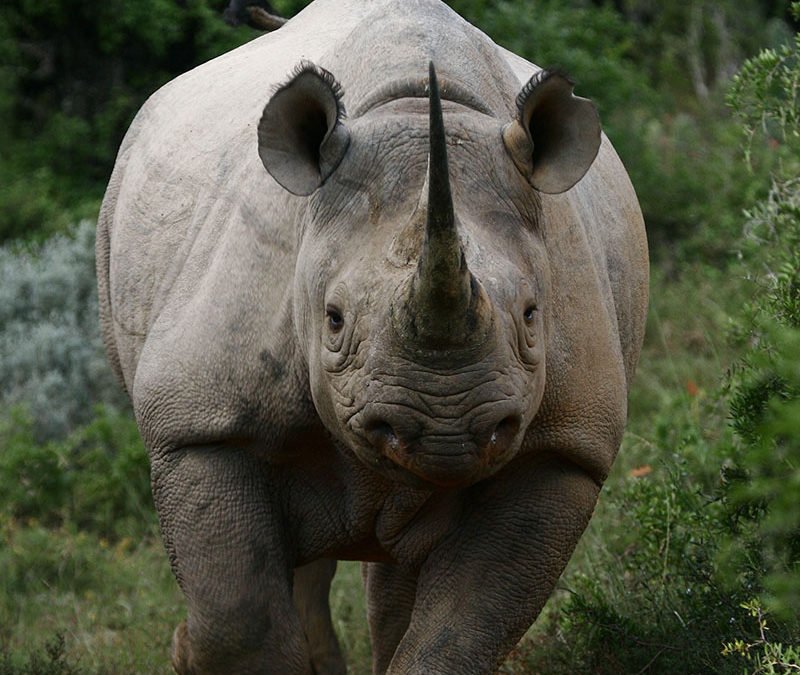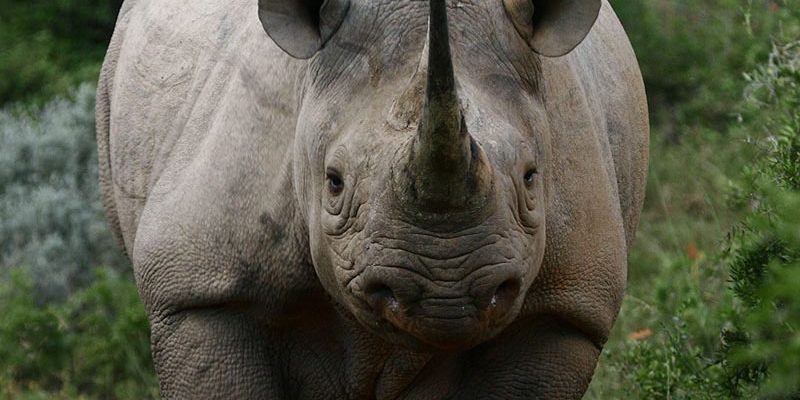
The Black Rhinoceros, or Diceros bicornis, is one of the most fascinating yet endangered creatures roaming our planet. Imagine a tank-like animal, with an armored body and a unique, pointed horn on its snout. It’s not just any rhinoceros; it’s a living testament to the beauty and struggles of the African wilderness. With a history steeped in both magnificence and peril, understanding this remarkable species opens a window into the wildlife challenges we face today.
Often mistaken for its larger cousin, the White Rhinoceros, the Black Rhinoceros is smaller and more nimble. You can find it grazing in the savannas, shrubs, and forests of Eastern and Southern Africa. Despite its robust appearance, the Black Rhinoceros is a sensitive animal with complex social behaviors. They captivate your attention, making you wonder about their lives, habitats, and the pressing issues that threaten their survival.
Physical Characteristics
The Black Rhinoceros is a standout in the animal kingdom largely due to its distinctive physical features. With an average height of about 4.5 to 6 feet at the shoulder, these rhinos can weigh anywhere between 1,000 to 1,400 pounds. They possess two prominent horns that can grow up to 14 inches long, adding to their unique profile. What’s truly fascinating is how each horn varies in shape and size—just another way nature showcases its creativity!
Unlike other rhinoceroses, the Black Rhinoceros has a more pointed upper lip, which aids in its feeding habits. This lip is prehensile, allowing it to grasp branches and leaves more effectively. When you see them munching away, it’s almost like watching a skilled artist at work, delicately twisting their mouth to pick just the right leaves. Their skin is thick and gray, appearing almost like armor—this helps protect them from the elements and, unfortunately, from poachers.
Habitat and Range
The Black Rhinoceros thrives in habitats that offer a blend of open savanna and dense bush, which provides both food and shelter. You’ll typically find them residing in countries like Kenya, Tanzania, and South Africa, where conservation efforts are most focused. These regions are a mix of grasslands and shrubs, allowing the rhinos to graze during the day and seek refuge from predators at night.
Interestingly, Black Rhinos have adapted to various environments, from dry deserts to lush forests. However, with habitat loss due to agriculture and urban expansion, their range has significantly shrunk. The critical areas where they roam are now often fragmented, making it vital for conservationists to create wildlife corridors—roads for animals that allow them to navigate their territories safely.
Diet and Feeding Habits
We cannot talk about the Black Rhinoceros without mentioning its diet. Being herbivores, they primarily feast on leaves, shrubs, and trees, often consuming over 100 pounds of vegetation in a single day! Their diet consists mainly of high-fiber plants, making their digestive systems quite efficient. In a way, they play a crucial role in their ecosystem by helping to maintain the balance between various plant species.
What’s particularly fascinating is their ability to strip leaves from branches, using those strong, pointed lips to maneuver around thorny bushes. It’s like a dance, where they skillfully avoid sharp thorns while munching on their favorite foods. Their feeding habits also contribute to the shaping of their habitats, as their grazing encourages new plant growth and fosters a diverse ecosystem.
Behavior and Social Structure
Black Rhinos are generally solitary creatures, with an interesting social structure. Unlike their white counterparts, they prefer to spend most of their time alone, with the exception of mothers and their young. Female rhinos exhibit an innate nurturing behavior, often staying close to their calves for up to three years before they head off to establish their own territories.
You might be wondering how they communicate. Black Rhinos use a range of vocalizations and body language to express themselves. Their high-pitched calls, along with snorts, grunts, and even visual displays, help them signal to others regarding territory or potential threats. It’s pretty remarkable how these huge animals can express such subtlety and nuance!
Conservation Status
The Black Rhinoceros is critically endangered, with populations dwindling due to habitat loss and poaching. The black market for rhino horns, often wrongly believed to have medicinal properties, poses a severe threat to their survival. Conservation programs are underway across Africa, with anti-poaching efforts and habitat restoration initiatives actively being pursued. It’s a tough battle, but there’s hope.
Many organizations around the world are dedicated to protecting these magnificent creatures. For example, the World Wildlife Fund (WWF) collaborates with local communities to promote conservation while ensuring that the rhinos can thrive in their habitats. This effort isn’t just about saving a species; it’s about safeguarding the entire ecosystem that supports countless other forms of life.
Interesting Facts
| Species Name: | Diceros bicornis |
| Weight: | 1,000 – 1,400 pounds |
| Height: | 4.5 – 6 feet at the shoulder |
| Diet: | Herbivorous (leaves, shrubs, trees) |
| Lifespan: | 35 – 50 years in the wild |
| Habitat: | Savannas, bushlands, forests |
| Current Population: | Approximately 5,500 remaining in the wild |
Human-Rhinoceros Interaction
Interactions between humans and Black Rhinos are complex, as they often find themselves at odds with expanding human activities. As humans encroach on their habitats for farming and urban development, rhinos face increasing dangers. Conflict can arise when livestock grazing overlaps with rhino territories, leading to a misunderstanding of these majestic animals’ needs.
However, there are numerous conservation projects aimed at educating local communities about the importance of the Black Rhinoceros. By fostering a better understanding of these animals, people can coexist more harmoniously with wildlife. It’s a step towards ensuring both the survival of the rhinos and the livelihoods of the communities that share their land.
Understanding the Black Rhinoceros is about more than just appreciating a unique species; it’s a call to action. While they may seem distant or removed from our daily lives, they play a vital role in the health of their ecosystems. From their incredible adaptations to their plight against extinction, every aspect of their existence deserves our attention and care. Together, we can foster a world where these magnificent creatures roam freely and thrive, ensuring that future generations can also marvel at their beauty.
FAQ
What do Black Rhinos eat?
Black Rhinos primarily eat leaves, shrubs, and the branches of trees. Their diet consists mainly of high-fiber plants, which they can consume in large quantities—up to 100 pounds a day! Their unique prehensile upper lips help them grasp and manipulate branches, allowing them to eat effectively, even from thorny plants. This adaptability in diet plays an essential role in maintaining the plant balance in their ecosystem.
How fast can a Black Rhinoceros run?
You might be surprised to learn that despite their large size, Black Rhinos can reach speeds of up to 30 miles per hour! This speed is quite impressive and allows them to escape from predators or threats in their habitat. While they may appear bulky and slow, they are surprisingly agile, which helps them navigate their environments efficiently.
Are Black Rhinos social animals?
Generally, Black Rhinos are solitary creatures. They prefer to live and forage alone, except for mothers with their calves. This solitary nature is different from some other rhino species, like the White Rhinoceros, which often form small groups. Female Black Rhinos tend to have a strong maternal bond with their young, staying close for several years before encouraging them to establish their own territories.
Why are Black Rhinos endangered?
The Black Rhinoceros faces critical endangerment due to a mix of habitat loss, poaching, and illegal wildlife trade. Poachers target them for their horns, which are prized in certain cultures for their supposed medicinal properties. As urban expansion encroaches on their habitats, finding adequate food and shelter has become increasingly challenging for these magnificent animals.
How can we help Black Rhinoceros conservation efforts?
There are several ways you can contribute to the conservation of Black Rhinos. Supporting wildlife organizations, participating in awareness campaigns, or even adopting a rhino through non-profit programs can make a difference. Education is vital—sharing information about their plight and engaging with local communities can also promote better coexistence with these unique creatures.
What is the lifespan of a Black Rhinoceros?
In the wild, Black Rhinoceroses can live between 35 to 50 years. Their lifespan varies depending on factors such as habitat conditions, food availability, and threats from poaching. Conservation efforts aim to improve their chances of a healthy lifespan, emphasizing the need for sustainable habitats and protection from illegal activities.
Where can I see Black Rhinos in the wild?
If you’re eager to catch a glimpse of Black Rhinos, the best places to visit are national parks and reserves in Africa, such as the Masai Mara in Kenya or Kruger National Park in South Africa. Many conservation programs offer guided tours where you can observe these magnificent animals in their natural habitats, while also learning about ongoing conservation efforts.
What distinguishes Black Rhinos from White Rhinos?
The primary difference lies in their size and social behavior. Black Rhinos are generally smaller than White Rhinos and have a more pointed upper lip, designed for grasping branches and leaves. Additionally, while White Rhinos tend to live in groups and have a more docile nature, Black Rhinos are more solitary and often more aggressive when threatened, making them unique among the rhinoceros species.
How do Black Rhinos contribute to their ecosystem?
Black Rhinos play a crucial role in their ecosystems as herbivores. Their grazing habits help maintain the growth of various plant species and prevent any one type from dominating the landscape. This balance fosters biodiversity, providing habitats for various other species in the ecosystem. In short, they are not just residents of their environment; they actively shape and support it.
What are the main threats to Black Rhinoceros survival?
The main threats to Black Rhinoceros survival include poaching for their horns, habitat loss due to agriculture and urban development, and conflicts with human populations over land use. Conservation efforts are crucial in combatting these threats and restoring their habitats to ensure that these magnificent creatures continue to thrive in the wild.

